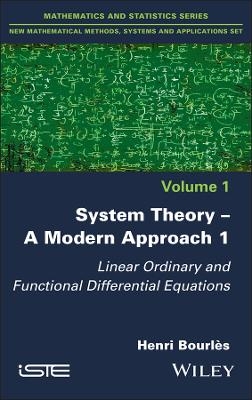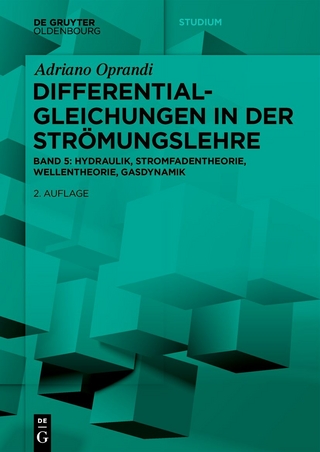
System Theory -- A Modern Approach, Volume 1
ISTE Ltd and John Wiley & Sons Inc (Verlag)
978-1-78630-985-3 (ISBN)
After a reminder of the evolution of the representation of systems based on transfer functions or matrices, the duality of controllability and observability is revisited, and new results are produced concerning time-varying discrete-time systems.
To complete and improve the existing analyses, the poles and zeros of linear systems and their interconnections are presented in a new way, as well as the problem of systems governed by functional differential equations (of retarded or neutral type) and their stabilization. This book also proposes known and original mathematical complements.
Henri Bourlès is Professor Emeritus at the Conservatoire National des Arts et Métiers and a researcher at the SATIE Laboratory (CNAM/ENS Paris-Saclay) in France. He has been teaching automatic control in engineering schools and universities for more than thirty years. His research work focuses on systems theory.
Preface ix
List of Notations xiii
Chapter 1. Representation of Systems: A Historical Overview 1
1.1. Transfer functions and matrices 1
1.1.1. Transfer functions 1
1.1.2. Transfer matrices 3
1.1.3. The discrete-time case 6
1.2. State-space representation 7
1.2.1. Continuous-time state-space systems 7
1.2.2. Discrete-time state-space systems 7
1.2.3. Controllability and observability 8
1.2.4. Poles of as state-space system 11
1.2.5. Stability of linear time-invariant systems 13
1.3. "Geometric" approach 14
1.3.1. Formalism of the geometric approach 14
1.3.2. Reachable and non-observable subspaces 15
1.3.3. State-feedback controls, observers 16
1.3.4. Canonical Kalmande composition, stabilizability and detectability 17
1.4. Polynomial matrix description 21
1.4.1. PBH test (Hautus criterion) 21
1.4.2. Rosenbrock representation 23
1.5. The behavioral approach 26
1.5.1. Controllability without control variables 26
1.5.2. Observability in the behavioral approach 30
1.6. Module of a system 32
1.6.1. Using modules in control theory 32
1.6.2. The Fliessian approach 33
1.6.3. Characterization in terms of modules of controllability and observability 34
1.7. The formalism of algebraic analysis 35
1.7.1. Nature of algebraic analysis 35
1.7.2. Oberst's contribution and its consequences 35
Chapter2. Linear Systems: Concepts and General Results 43
2.1. Control systems 43
2.1.1. The formalism of control systems 43
2.1.2. Transfer matrix: general case 45
2.1.3. State-space representation of a control system 46
2.2. Strict equivalence of Rosenbrock systems 49
2.2.1. Admissible Rosenbrock representations 49
2.2.2. Strict equivalence 51
2.3. Controllability, observability and their duality: the algebraic point of view 55
2.3.1. Algebraic controllability 55
2.3.2. Algebraic controllability of state-space systems (continuous time) 57
2.3.3. Algebraic controllability of state-space systems (discrete-time) 63
2.3.4. Algebraic duality 66
2.3.5. Algebraic observability and the algebraic duality principle 74
2.4. Reachability, observability and their duality: Kalmanian point of view 77
2.4.1. Complete controllability of a state-space system (continuous time) 78
2.4.2. Complete reachability and controllability of a state-space system (discrete-time) 83
2.4.3. Observability of state-space systems (continuous-time) 86
2.4.4. Complete observability and constructability of state-space systems (discrete-time) 91
Chapter 3. Poles and Zeros of Linear Systems, Interconnectedness and Stabilization 97
3.1. Poles and zeros of continuous or discrete invariant linear systems 97
3.1.1. System poles, transmission poles and zeros 97
3.1.2. Input-output-decoupling zeros and hidden modes 109
3.1.3. Relations between poles, transmission poles and hidden modes 112
3.1.4. Invariant zeros 113
3.1.5. Dynamic interpretation of different poles and zeros 118
3.2. Poles and zeros of interconnected systems 119
3.2.1. Diagram of a control system 119
3.2.2. System interconnection 120
3.2.3. Series interconnection 121
3.2.4. Parallel interconnection 126
3.2.5.Feedback interconnection 129
3.2.6. Youla-Kucera parametrization of stabilizing controllers 135
Chapter 4. Systems with Differential Equations and Difference Equations 145
4.1. Systems governed by functional differential equations 145
4.1.1. Functional differential equation of retarded type 146
4.1.2. Functional differential equations of neutral type 147
4.1.3. Case of infinite delays 149
4.1.4. Linear functional differential equations 151
4.1.5. Stability of functional differential equations 156
4.2. Time-in variant linear systems with lumped delays 159
4.2.1. Definition and simplified framing 159
4.2.2. Commensurability or incommensurability of delays 162
4.2.3. Case of commensurable delays 162
4.2.4. Homological questions 165
4.3. Time-invariant linear systems with distributed delays 172
4.3.1. RingH: case of non-commensurable delays 172
4.3.2. RingsH and H0: case of commensurable delays 180
4.3.3. Controllability and observability of H-systems 181
4.3.4. Stability of H-systems 182
4.3.5. Poles and zeros of H-systems 185
Appendix. The Mathematics of the Theory of Systems 187
References 267
Index 279
| Erscheinungsdatum | 23.08.2024 |
|---|---|
| Verlagsort | London |
| Sprache | englisch |
| Gewicht | 730 g |
| Themenwelt | Mathematik / Informatik ► Mathematik ► Analysis |
| ISBN-10 | 1-78630-985-8 / 1786309858 |
| ISBN-13 | 978-1-78630-985-3 / 9781786309853 |
| Zustand | Neuware |
| Haben Sie eine Frage zum Produkt? |
aus dem Bereich


